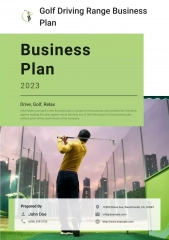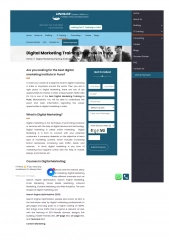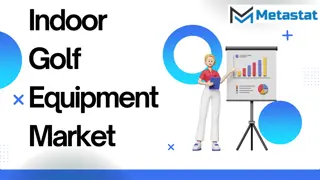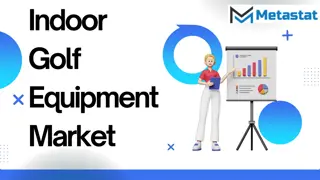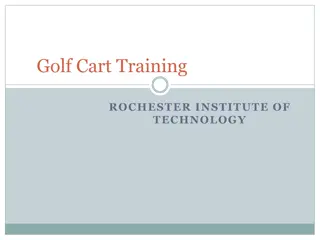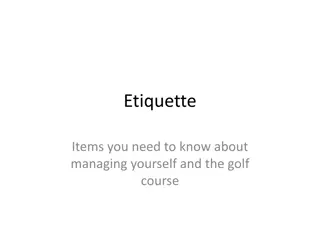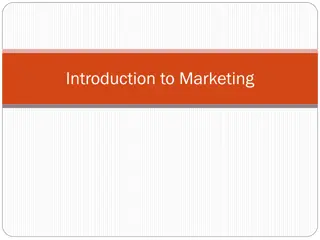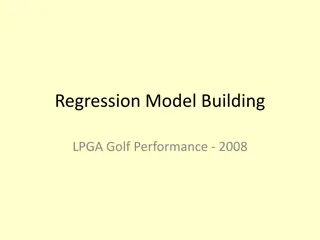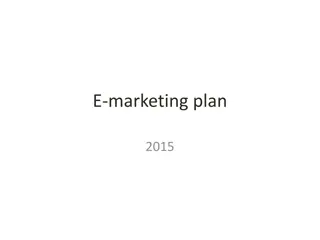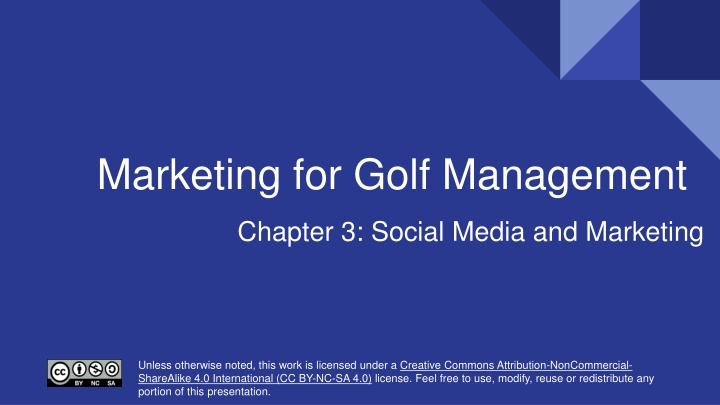
Enhancing Golf Marketing Strategies with Digital Technologies
Discover the impact of social media and email marketing in golf management, along with the technological advancements shaping the industry. Learn about executing successful email campaigns and leveraging customer relationship management for business growth.
Uploaded on | 0 Views
Download Presentation

Please find below an Image/Link to download the presentation.
The content on the website is provided AS IS for your information and personal use only. It may not be sold, licensed, or shared on other websites without obtaining consent from the author. If you encounter any issues during the download, it is possible that the publisher has removed the file from their server.
You are allowed to download the files provided on this website for personal or commercial use, subject to the condition that they are used lawfully. All files are the property of their respective owners.
The content on the website is provided AS IS for your information and personal use only. It may not be sold, licensed, or shared on other websites without obtaining consent from the author.
E N D
Presentation Transcript
Marketing for Golf Management Chapter 3: Social Media and Marketing Creative Commons Attribution-NonCommercial-ShareAlike 4.0 International (CC BY-NC-SA 4.0) Creative Commons Attribution-NonCommercial-ShareAlike 4.0 International (CC BY-NC-SA 4.0) Unless otherwise noted, this work is licensed under a Creative Commons Attribution-NonCommercial- ShareAlike 4.0 International (CC BY-NC-SA 4.0) license. Feel free to use, modify, reuse or redistribute any portion of this presentation.
3.0 Learning Objectives In this chapter, we will: Review different marketing technologies within the golf industry. List the nine steps of an e-mail campaign. Demonstrate best practices for executing an e-mail campaign. Describe how PPC (pay per click) works. Outline what makes up a PPC advertisement. Explain why e-CRM (electronic customer relationship management) is an important part of business. Discuss how businesses put a value on CRM (customer relationship management) for their organizations.
3.1 Technology While social media marketing can take up a lot of marketers attention, it only represents one component of a digital marketing strategy The realm of golf has undergone substantial changes, with technology playing a pivotal role in shaping the sport Digital Golf Equipment Advancements Swing Analysis Technology Golf Course Management Connectivity and Mobile Apps Live Streaming and Virtual Reality Future Wearable Technology Environmental Sustainability Technological Developments
3.2 Email Marketing Email Marketing is a form of direct marketing that utilizes electronic means to deliver commercial messages to an audience At its core, email marketing is a tool for customer relationship management (CRM) Used effectively, this extension of permission-based marketing can deliver one of the highest returns on investment (ROI) of any eMarketing activity. The power comes from the fact that it is the following: Extremely cost-effective due to a low cost per contact Highly targeted Customizable on a mass scale Completely measurable Every email your organization sends should be considered part of your holistic email marketing strategy (i.e. transactional emails, newsletters, promotional emails) There are two types of commercial emails: promotional emails and retention-based emails
3.3 Nine Steps to Executing an Email Campaign There are nine steps to executing an email campaign properly 1. Strategic planning 2. Definition of list 3. Creative execution 4. Integration of the campaign with other channels 5. Personalization of the message 6. Deployment 7. Interaction handling 8. Generation of reports 9. Analysis of results Figure 3.3.1: Steps to Executing an Email Campaign
3.3 Step 1: Strategic Planning Define campaign goals Identify key performance indicators (KPIs), also known as key success indicators (KSIs) Promotional emails will usually have an immediate goal: Users make a purchase Users download a white paper Users request further information KPIs for newsletters: Open rate Click-through rate Forwarded emails Return on Investment (ROI) A successful email campaign is most likely to be the one geared at retaining and creating a long-term relationship with the reader.
3.3 Step 2: Definition of List Obtain genuine opt-in permission for email campaigns The subscriber list is the most valuable asset Explicit permission is crucial to avoid reputation damage and legal issues Key considerations for the database entry: First name, surname, and title Date permission granted Source of permission Country Telephone number Date of birth Attract prospects with strategic opt-in methods, like website sign-up forms
3.3 Step 3: Creative Execution Email formats: HTML (graphics, interactive) and text (plain) HTML emails can contain images, fonts, and hyperlinks Text emails are plain (only text), smaller, and simpler Parts of an Email: Header: Build familiarity and trust. Use a personalized company email address Subject line: Crucial for identification and enticing readers. Avoid spam trigger words Personalized greeting: Boost responses with specific user greetings Body: Avoid excessive images and ensure text is readable without image loading Footer: Standardize for consistency. Include contact info and privacy policy Unsubscribe link: Mandatory in all commercial emails Interactive emails are best constructed with lightweight HTML capability allowing the email to open quickly The structure must allow readers to scan and navigate the email easily
3.3 Step 4: Integration of Campaign with Other Channels While email marketing can operate as a stand-alone marketing campaign, integrating it with other channels, both online and offline, will serve to both reinforce a brand s message and increase responses. There should never be a disparity between the content, tone, or design of an email when compared to the rest of a company s offerings In-store promotions can be reinforced and promoted to an email database, or Web site information can be summarized for email Custom landing pages, as required, should be created for any promotions being communicated in an email communication
3.3 Step 5: Personalization of the Message The technology of email marketing allows for mass customization Even simple personalization can see improved results. Customization starts at using the recipient s name and sending either HTML or text emails based on preference, to sophisticated measurement of a recipient s preferences and tailoring content to suit them Segmenting a database can allow for customization across demographics or purchase history Being able to reconcile browsing activity to an email recipient can give further opportunities for customization using artificial intelligence (AI).
3.3 Step 6: Deployment By creating valuable content, establishing the correct frequency, and testing an email for display and deliverability, an email marketer should be able to ensure an excellent delivery rate Consistency in deploying newsletters also aids in fostering trust and fulfilling expectation. Emails should be delivered at consistent times, but the optimum time for best results should be tested Becoming an effective email marketer requires constant list cleansing and hygiene An email white list is a list of contacts that the user deems are acceptable to receive email from and should not be sent to the trash folder. When should you send emails? Common sense tells you not on Monday morning or Friday afternoon, but it varies by audience. Testing will guide you Permission must be explicitly given to the company to be allowed to market to that user
3.3 Step 7: Interaction Handling Every interaction via email should be considered as part of a company s email marketing practice Automated emails, such as order confirmations and even out of office replies, are all opportunities to engage with customers. If a company has a particular tone or content style, this must be reinforced in these interactions These emails can also be an opportunity to cross-advertise other promotions that a company is offering.
3.3 Step 8: Report Generation As with all things eMarketing, tracking, analyzing, and optimizing is key to growth Email tracking systems produce statistics in a user-friendly manner The following are key measurables for understanding the performance of email campaigns: Number of emails delivered Number of bounces Number of unique emails opened Unsubscribes Pass-on rate: The percentage of e-mails that are forwarded Click-through rates and conversion
3.3 Step 9: Analysis of Results Once the reports have been generated, it is time to work out what the numbers are revealing and to use this information to improve the next e-mail sent out. With email marketing, split testing across a host of factors will enable campaign optimization. The following are some factors to test: Open rates across different subject lines and delivery times Optimal number of links in an email for click-through rates and conversions Different copy styles and copy length The effect of video on delivery rates, open rates, and conversions
3.4 Pay per Click Advertising Pay-per-click (PPC) advertising is an advertising system where the advertisers pay only for each click on their advertisements PPC advertising is keyword-based, which is based on the search term that a user enters into a search engine For the advertiser, the beauty of PPC advertising on search engines is that their advertisements are displayed when potential customers have already expressed intent Advertisers can choose to have their advertisements displayed on the search network only or they can select to have the advertisements displayed on the content network Text PPC advertisements follow the same basic structure: Heading Two lines of advertisement copy, Which can be displayed on one line www.DisplayURL.com
3.4 Pay per Click Advertising - How It Works Search engines have their own pay-per-click (PPC) advertising, for instance, Google has AdWords. With PPC advertising, the advertiser does the following: Creates the content for an advertisement Select the keywords. This is a word found within a search query Chooses the maximum amount they are willing to pay for a click on the advertisement The search engine algorithm does the following: Check the advertisement for compliance to editorial guidelines Advertises relevant search queries Determines the rank, or position, of the advertisement based on the advertiser s maximum bid and the relevance of the advertisement (which includes factors such as click-through rate [CTR], ad copy, keywords, and landing-page relevance to the search)
3.4 The Long Tail Google has estimated that 50 percent of searches are unique. This means that the sum of unique searches is about the same as the sum of nonunique searches. Looking a little more closely at search terms will show a small number of high-volume searches, and then a large number of lower volume searches stretching out to those unique searches. In the long tail, the sum of the low-volume searches matches the high-volume searches. Figure 3.4.2: The long tail diagram showing how the sum of unique searches roughly equals the sum of non-unique searches

